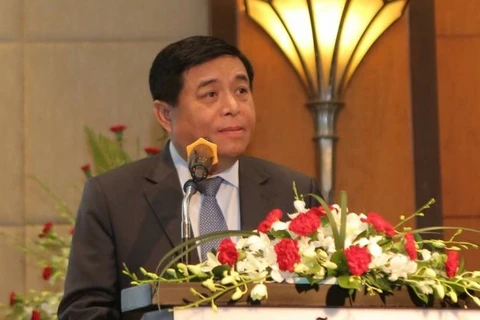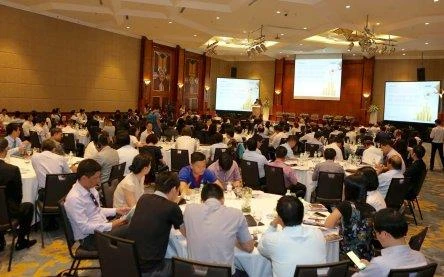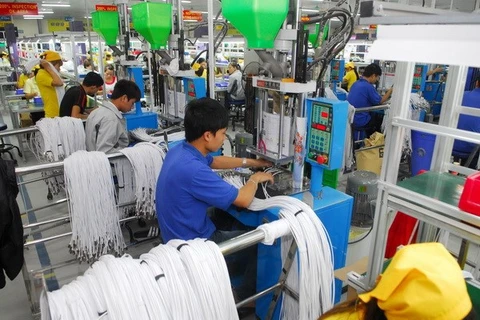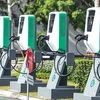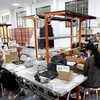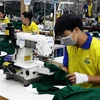Hanoi (VNA) - Vietnam’s economy could grow by 7.02 percent in 2018 under a high growth rate scenario, according to the National Center for Socio-Economic Information and Forecast (NCIF).
The NCIF predicted two economic development scenarios for Vietnam’s economy this year, including a basic scenario marked by a medium growth rate and a high economic growth rate scenario.
According to the NCIF, the basic scenario is more likely to occur. Under this scenario, investment in the public sector would help maintain a steady growth rate, playing an important role in regulating the economy.
This economic model could see more restructure, but the capital and exports are expected to remain the backbone of economic development. The financial system is projected to maintain its stability, while financial and monetary management are expected to become flexible.
Domestic economic growth this year could reach 6.83 percent under this scenario, while inflation is projected to remain low at about 4.5 percent.
The NCIF forecasts a higher GDP growth rate under the high economic growth rate scenario if the economy can sustain the results expected in the basic scenario in addition to government efforts in economic reform and governance aimed at removing bottlenecks in several sectors of the economy, including land policy, credit and administration.
These efforts are expected to create a favorable business environment for the development of the business community. Under this scenario, the economy could grow by 7.02 percent in 2018, with average inflation at 4.8 percent.
The NCIF said national economic growth in 2018 is expected to sustain its upward trend, as global economic development could have positive effects on domestic economic activity. Government efforts to remove economic roadblocks put in place in 2017 are expected to have more impact in 2018.
Newly signed free trade agreements are projected to bring breakthroughs in investment as well as the expansion of export markets. Localities and ministries have also initiated efforts to improve the business investment environment. These are expected to boost domestic economic development by the end of the year.
Regarding the development of specific sectors, the centre said production and business activities of enterprises are also likely to improve. Despite facing many difficulties in 2017, Vietnamese enterprises have more opportunities to develop in 2018, with their focus on their core business, allowing them to adapt to the increasing competition, reported vov.vn.
The NCIF also projected 2018 will be the year that Vietnam’s enterprises are able to integrate further into the regional and world markets. The promotion of corporate equitisation and development of the private sector this year will promote economic growth in the coming years, the NCIF said.
In addition to the Small and Medium-sized Enterprise Support Law, which took effect on January 1, enterprises are also expected to focus on developing advanced management strategies to enable themselves to do business in the global economy.
A number of large enterprises, such as Samsung and Formosa, are predicted to experience major expansion in terms of production and business this year, boosting growth in the processing and manufacturing industry and creating momentum for domestic economic development.
The NCIF also said successful trade agreements could provide an opportunity to attract foreign direct investments into Vietnam, not only in term of new investment but also additional investment in existing projects.
The NCIF forecast highlighted positive factors in the import and export sectors due to improvements in cooperative relations between Vietnam and other countries.
Higher growth rates in Vietnam’s key partners could increase demand for Vietnamese goods, the NCIF said. Prices of key commodities are also projected to increase, which could expand Vietnam’s trade value.
Export levels are also expected to grow due to a recovery in domestic production. The upward trend in consumer spending is likely to continue this year while inflation is expected to remain under control, the NCIF said.
However, the NCIF said internal economic problems, including unsophisticated technology and the gradual exhaustion of land and natural resources, still pose a major challenge for domestic economic growth. While there have been developments in productivity, efficiency, and competitiveness, the economy is still in search of a real breakthrough, the NCIF said.
Vietnam’s labour market this year could face numerous challenges from the fourth industrial revolution (4.0 Industry), which affects all aspects of the economy and society, especially, the textile and electronics sectors that have used a large number of labour.-VNA
VNA

